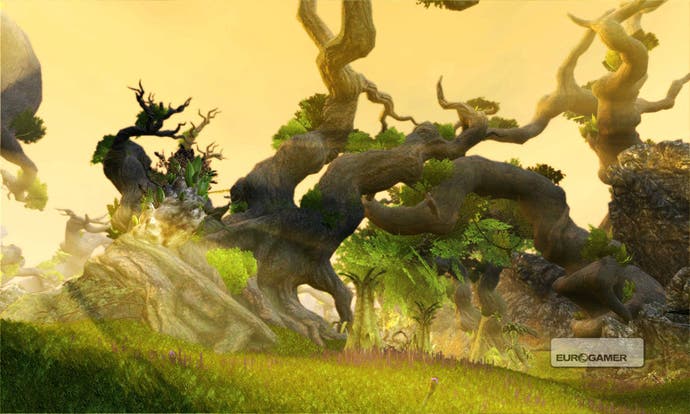Age of Conan: Rise of the Godslayer
Die another deity.
It's all intended to give the game more variety, something else it was missing at launch, and something that would probably have been an official watchword for the expansion if it didn't start with the wrong letter. Morrison shows video of a team of testers making their way through a dungeon called the Celestial Necropolis in the Khara Khorum zone, which has some unusual mechanics that he's particularly proud of. Players have to use emote animations while standing on pads to form a bridge, three of them holding their poses while the other three run across and fight. The gimmick returns in the final boss fight, where players actually have to copy the emotes used by the dungeon's overlord. (Every playfield has three dunegons, Morrison adds, and they all have a hard mode.)
The principal variety and replayability in Rise of the Godslayer come from the factions. There are 10 factions for players to ally with, coming in antagonistic, mutually exclusive pairs. They have entirely separate quest content - so two playthroughs of the Khitai zones could go very differently, depending which factions you choose - and most players are only expected to engage with three to five of them at once. There are also a further two "hidden" factions: "They're two key groups that are very pivotal to the situation that the players will discover in Khitai, that they may get to align themselves with based on how they go through the quests," Morrison says.
But if anything, Morrison is as interested in the factions' impact on the tone and themes of Age of Conan as their gameplay implications. He wants the choice between them to be more meaningful than whose armour set is coolest, or whose enchantments are best suited to your class - and not drawn along strict good-and-evil lines, either.
"The Priests of Yag-kosha are one of the factions in the game, and the writers introduce them as a very humble, very noble sect of priests who used to worship Yag-kosha as a god, and they're very visible to the player as good guys," he says. The problem is that Yag-kosha is the elephant god Conan killed in Robert E Howard's story The Tower of the Elephant, lending this expansion its foothold in Conan lore as well as its title. It was a mercy killing, but it had terrible implications for Khitai and remains pretty unpopular with the god's followers.

"These people are helping their community, they're dedicated, but their goal is to kill Conan because he killed their god, and he must pay. And Conan's your King. So it presents players with this kind of morally ambiguous choice," Morrison continues. "Robert E Howard always wrote about shades of grey. His world wasn't black and white. He believed society was corrupt and civilisation would destroy itself from the inside out. Khitai is really the embodiment of that, we're really trying to drive those themes that Howard wrote about."
With Khitai only existing on the periphery of the Conan universe, Funcom's had great freedom to develop this expansion as it sees fit, to take possession and control of its virtual world. But Morrison believes that, if anything, it's taking Age of Conan closer to the source material than ever before. "Howard only wrote four or five lines about Khitai in his writing and it gave us some great visual licence to create a world that hasn't been created before. But in terms of themes, I would love to think that if Howard was still around today, this is the Khitai he would have written about."
Age of Conan: Rise of the Godslayer is due for release in the first half of 2010.


